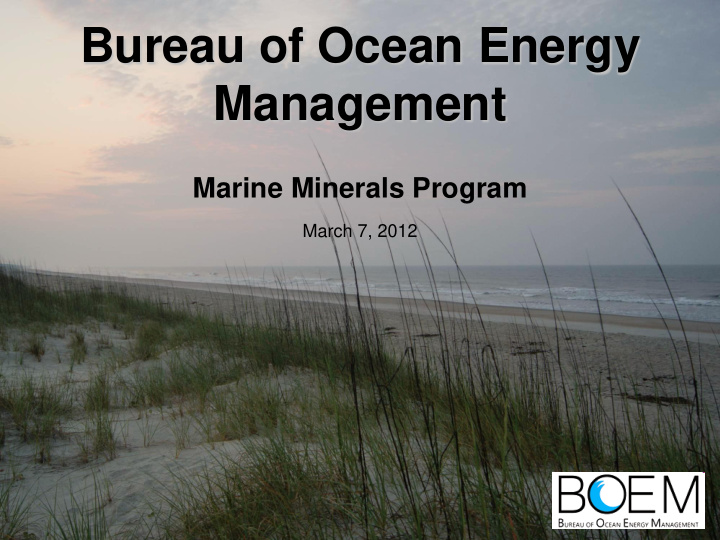



Bureau of Ocean Energy Management Marine Minerals Program March 7, 2012
Marine Minerals Program The Outer Continental Shelf Lands Act (OCSLA) (43 U.S.C. 1331, et. seq.) provides the authority to manage minerals on the OCS 58 million cubic yards of OCS sand conveyed through 31 negotiated noncompetitive agreements Projects completed in Florida, Louisiana, Maryland, South Carolina and Virginia 180 miles of the Nation’s shoreline have been replenished/restored Slide 2
Impact of Program National Defense U.S. Air Force (Patrick AF Base, FL) U.S. Navy (Dam Neck Naval Facility, VA) NASA Space Program Wallops Island, VA Habitat Restoration Pelican Island/Raccoon Island, LA Marsh Creation National Park Service, Assateague Island, MD Storm & Infrastructure Protection Brevard County, FL Myrtle Beach, SC Provide resources that impact tourism, the largest U.S. industry Slide 3
Ongoing Projects Florida Virginia Brevard County – Mid Reach Dam Neck Naval Base Brevard County _ Submerged Bar Fort Story Naval Base Cape Canaveral Sandbridge Beach Collier County Wallops Island Duval County North Carolina Flagler County Bogue Bank Longboat Key Brunswick County Martin County Surf City / North Topsail Miami Dade West Onslow Beach and New River Mid Reach Brevard County Inlet Patrick Air Force Base Pinellas County Louisiana St. Lucie County Cameron Parish Caminada Headland Maryland Pelican Island Atlantic Coast of Maryland Raccoon Island Slide 4
Potential Future Nourishment Projects (Beyond 2012) Ocean Beach, California Rehoboth / Dewey Beach, Delaware Bethany / South Bethany, Delaware Barataria Basin, Louisiana Terrebonne Basin Barrier Shoreline, Louisiana Absecon Island, New Jersey Long Beach Island, New Jersey Slide 5
Program Workload & Staff
Collaboration and Partnerships 3 Established Sand Management Working Groups (LA, FL, Mid-South Atlantic) Army Corps of Engineers New Programmatic MOU ACOE Road Show Environmental Coordination Other Collaboration Efforts NOAA NMFS FWS Federal Recipients (NASA, NPS, DOA, US Navy, US Air Force) State Agencies (LA DNR, FL DEP, VA DEQ, etc.) Slide 7
Roll of Science in Restoration and Planning
State Cooperative Agreements State Coop Program formed in 1992 Focus on identification & assessment of OCS sand resources 50/50 cost sharing of work between State and BOEM 16 states have participated at various times More than $7.5 million spent resulting in 67 completed studies In 2010, 3 State Coops funded: FL, LA and VA. Volume of Material Leased from State Total COOP $ Spent COOP (cy) LA $1,282,136.00 20,476,000 FL $1,131,994.00 14,473,000 VA $700,139.00 9,919,575 SC $455,134.00 9,074,100 MD $530,383.00 2,034,000 Slide 9
State participation in Cooperative Agreement Program
Environmental Studies $12 million spent on Environmental Studies More than 40 studies Site-Specific and Programmatic 8 Ongoing programmatic studies Have been referenced or represented in: International Studies Nationwide Studies Peer Reviewed Journal Articles USACE Analysis and Reasearch FWS/NMFS documents Master thesis and PhD dissertations Conference presentations/proceedings In-house documents Slide 11
Benthic Communities Care is taken to reduce the impact of benthic communities Consultations (NMFS) Monitoring of dredges as they operate Studies Best Practices to Reduce Physical Impacts During Dredging 3D morphological model for near and far field impacts associated with modifying bathometry Determination at what depth modeling can cease (impact on the seafloor is negligible) Slide 12
Archaeology National Historic Preservation Act (NHPA) - Section 106 Archaeological survey and report Identification of significant archaeological / cultural resources Avoidance and/or additional survey Sonar image of the Jordan Bridge shipwrecks. Slide 13
Future of Restoration in the Gulf of Mexico
Wetlands and Critical Habitat Restoration Current Projects Pelican Island Raccoon Island Raccoon Island - 1997 Future Projects Cameron Shoreline Restoration Barataria Basin Shoreline Terrebonne Barrier Shoreline Raccoon Island - 1999 Slide 15
Challenges in Coastal Restoration
Challenges Looking Forward Increasing Need for OCS Material Decreasing supply of material available in State Waters Sea level rise due to climate change Increased storm activity Increasing Concerns Funding Sources (Federal, State & Local) Coastal Ecosystem Degradation (Wetlands, Barrier Islands, Beaches) Marine Spatial Planning/Multi-Use Conflicts Climate Change Environmental Impacts Coastal Fisheries and Hatcheries National Commerce Slide 17
Strategic Thinking: Addressing Challenges A Regional Approach Sand Management Working Groups Regional NMFS Biological Opinions Streamlined Processes Identifying environmental studies based on prioritized information gaps Placement of Regional staff dedicated to MMP Consideration of Multi-Use Issues Effort to make sand resource location information more publicly accessible (Multi- Purpose Marine Cadastre) Slide 18
Conclusions In the past 20 years the MMP has… Spent ~$38 million dollars total (including base salary) Employed an average of 5 FTE/year Conveyed 58 million cubic yards of OCS material Signed 31 negotiated noncompetitive agreements Replenished/Restored more than 180 miles of the Nation’s coastline Completed 67 State cooperative agreement resource identification studies Completed over 40 environmental studies Established 3 regional working groups Slide 19
Recommend
More recommend